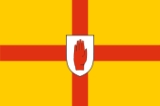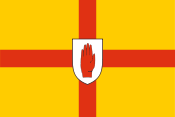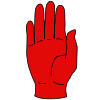
Flag of Ulster
Encyclopedia

Ulster
Ulster is one of the four provinces of Ireland, located in the north of the island. In ancient Ireland, it was one of the fifths ruled by a "king of over-kings" . Following the Norman invasion of Ireland, the ancient kingdoms were shired into a number of counties for administrative and judicial...
, one of the four provinces
Provinces of Ireland
Ireland has historically been divided into four provinces: Leinster, Ulster, Munster and Connacht. The Irish word for this territorial division, cúige, literally meaning "fifth part", indicates that there were once five; the fifth province, Meath, was incorporated into Leinster, with parts going to...
of Ireland
Ireland
Ireland is an island to the northwest of continental Europe. It is the third-largest island in Europe and the twentieth-largest island on Earth...
. It is still used today to represent the province at some sporting events and formed the basis of the Ulster Banner
Ulster Banner
The Ulster Banner, more commonly known as the Ulster flag, Northern Ireland flag or the Red Hand of Ulster flag, was the flag of the Government of Northern Ireland between 1953 and 1972. Since that government was abolished in 1972, the flag has become a symbol of Ulster loyalism and is not...
, the flag of the Government of Northern Ireland
Government of Northern Ireland
The Government of Northern Ireland is, generally speaking, whatever political body exercises political authority over Northern Ireland. A number of separate systems of government exist or have existed in Northern Ireland....
between 1953 and 1972. The Red Hand of Ulster
Red Hand of Ulster
The Red Hand of Ulster is a symbol used in heraldry to denote the Irish province of Ulster. It is less commonly known as the Red Hand of O'Neill. Its origins are said to be attributed to the mythical Irish figure Labraid Lámh Dhearg , and appear in other mythical tales passed down from generation...
is a symbol derived from the O'Neill dynasty
O'Neill dynasty
The O'Neill dynasty is a group of families that have held prominent positions and titles throughout European history. The O'Neills take their name from Niall Glúndub, an early 10th century High King of Ireland from the Cenél nEógain...
who were historic monarchs of the provincial kingdom, while the gold background featuring a red cross comes from the coat of arms of the Burkes, a Hiberno-Norman
Hiberno-Norman
The Hiberno-Normans are those Norman lords who settled in Ireland who admitted little if any real fealty to the Anglo-Norman settlers in England, and who soon began to interact and intermarry with the Gaelic nobility of Ireland. The term embraces both their origins as a distinct community with...
noble family.
History

Kings of Ailech
The Kings of Ailech belonged to the northern Uí Néill and took their name from the Grianán of Ailech , a hillfort on top of Greenan Mountain in modern County Donegal...
and Tír Eoghan
Kings of Tir Eogain
This article lists the Kings of Tír Eoghain or Tyrone from 1185 to 1616. They are listed from their date of accession to date of death, unless otherwise stated....
.
The celebrated 'Red Hand' badge of O'Neill was probably grounded on a theme in Gaelic mythology. It may have originally symbolized the pre-Christian Celtic sun-god Nuadu – 'he who dwells in the clouds'. The latter's well-known designation, Argatlámh signified 'silver Hand' and his alias Bolg had a son, (mythologically speaking) named "Lámhdearg-Labraid" (Red Hand). Nuadu and Bolg were appellations of the Érainn or Ivernic, sun-god, the equivalent term in the Gaelic language being Nél.
The open right hand, the Dextera Dei
Hand of God (art)
The Hand of God, or Manus Dei in Latin, also known as Dextera domini/dei, the "right hand of the Lord/God", is a motif in Jewish and Christian art, especially of the Late Antique and Early Medieval periods, when depiction of Jehovah or God the Father as a full human figure was considered...
, has also been employed as a Christian symbol. In early Christian iconography
Iconography
Iconography is the branch of art history which studies the identification, description, and the interpretation of the content of images. The word iconography literally means "image writing", and comes from the Greek "image" and "to write". A secondary meaning is the painting of icons in the...
God the Father
God the Father
God the Father is a gendered title given to God in many monotheistic religions, particularly patriarchal, Abrahamic ones. In Judaism, God is called Father because he is the creator, life-giver, law-giver, and protector...
was frequently represented by the open right hand occasionally within a circle or nimbus. An example of this motif can be seen on one of the arms of the 10th century High Cross of Muiredach at Monasterboice, County Louth. It signifies the support of God the Father for the Kingdom of Christ on earth. An early heraldic use in Ireland of the open right hand can be seen in the seal of Odonis (Hugh) O Neill, king of the Irish of Ulster, 1344-1364.
When Walter de Burgh
Walter de Burgh, 1st Earl of Ulster
Walter de Burgh was 2nd Lord of Connaught and 1st Earl of Ulster .De Burgh was the second son of Richard Mór de Burgh, 1st Lord of Connaught and Egidia de Lacy. He founded Athassel Priory....
, Lord of Connacht
Connacht
Connacht , formerly anglicised as Connaught, is one of the Provinces of Ireland situated in the west of Ireland. In Ancient Ireland, it was one of the fifths ruled by a "king of over-kings" . Following the Norman invasion of Ireland, the ancient kingdoms were shired into a number of counties for...
, became Earl of Ulster in 1243 the de Burgo cross became inseparably linked with the province of Ulster. The seal of his son Richard, for example, appended to a deed dated 1282, shows the heraldic cross in triplicate together with what may well be a portrait head of the Earl himself.
The Uí Néill
The term Uí NéillUí Néill
The Uí Néill are Irish and Scottish dynasties who claim descent from Niall Noigiallach , an historical King of Tara who died about 405....
denotes "grandsons/descendants of Niall", the ancestor noted being Niall of the Nine Hostages
Niall of the Nine Hostages
Niall Noígíallach , or in English, Niall of the Nine Hostages, son of Eochaid Mugmedón, was an Irish king, the eponymous ancestor of the Uí Néill kindred who dominated Ireland from the 6th century to the 10th century...
(Niall Noigíallach), a legendary Connacht
Connacht
Connacht , formerly anglicised as Connaught, is one of the Provinces of Ireland situated in the west of Ireland. In Ancient Ireland, it was one of the fifths ruled by a "king of over-kings" . Following the Norman invasion of Ireland, the ancient kingdoms were shired into a number of counties for...
king active in the first half of the 5th century. His sons, grandsons and great-grandsons attacked the kingdoms of In Tuisceairt, Airgíalla
Airgíalla
Airgíalla or Airgialla was the name of an Irish federation and Irish kingdom which first formed around the 7th century...
, Ulaid
Ulaid
The Ulaid or Ulaidh were a people of early Ireland who gave their name to the modern province of Ulster...
, Cenél Maine, Tethba, Mide and Leinster
Leinster
Leinster is one of the Provinces of Ireland situated in the east of Ireland. It comprises the ancient Kingdoms of Mide, Osraige and Leinster. Following the Norman invasion of Ireland, the historic fifths of Leinster and Mide gradually merged, mainly due to the impact of the Pale, which straddled...
in the generations after his death, either ruling directly or via vassal kings. The dynasty subsequently divided into two main divisions: the Clann Cholmáin
Clann Cholmáin
Clann Cholmáin is the name of the dynasty descended from Colmán Mór , son of Diarmait mac Cerbaill. Part of the Southern Uí Néill — they were the kings of Mide — they traced their descent to Niall Noígiallach and his son Conall Cremthainne.Related dynasties descended through Conall...
Kings of Mide
Kings of Mide
In medieval Ireland, the Kings of Mide were of the Clann Cholmáin, a branch of the Uí Néill. Several were High Kings of Ireland. After the collapse of the kingdom in the 12th century its dynasty, the Ua Mael Sechlainn or Ó Melaghlins, were forced west and settled on the east bank of the Shannon...
, who later adopted the surname Ua Maél Séchlainn and ruled central Ireland; and the Uí Néill In Tuisceart (the Uí Néill of The North), whose senior line took the surname Ó Néill and ruled as Kings of Tir Eoghan until 1607.
Coats of arms used by individuals bearing surnames of families of Uí Néill descent - Ó Cathain
Ó Cathain
Clan Ó Catháin ....
(now Keane), Ó Maelsechlainn (now McLoughlin), Mac Loughlin (now McLaughlin), Ó Catharnaigh of Donegal (now Kearney) and Ó Neill/O'Neill
O'Neill dynasty
The O'Neill dynasty is a group of families that have held prominent positions and titles throughout European history. The O'Neills take their name from Niall Glúndub, an early 10th century High King of Ireland from the Cenél nEógain...
, O'Lorcain (now Larkin) and others all feature the red hand in some manner, recalling their common descent.
Origin legend
The story of the Red Hand of UlsterRed Hand of Ulster
The Red Hand of Ulster is a symbol used in heraldry to denote the Irish province of Ulster. It is less commonly known as the Red Hand of O'Neill. Its origins are said to be attributed to the mythical Irish figure Labraid Lámh Dhearg , and appear in other mythical tales passed down from generation...
reputedly dates to the arrival of Heremon, Heber
Heber
Heber may be:-Religious traditions:*One of the Minor characters in the Book of Genesis*Heber the Kenite, mentioned in the Book of Judges 4:17 of the Hebrew Bible as Jael's husband...
and Ir
IR
Ir or ir may refer to:* the abbreviation for the title of Ingénieur , a person practicing the profession of engineering* Iridium , the 77th element* .ir, the Internet country code top-level domain for Iran...
- sons of King Milesius of Spain (Galicia), who were dispatched to conquer Ireland in 504 BC. One of them supposedly cut off his hand and tossed it ashore, that he might be the one to have first claim to the land. There is another story about the hand belonging to one of two giants engaged in battle, whose hand was cut off in the process and left a red imprint on the rocks. A third story recounts how Uí Néill
Uí Néill
The Uí Néill are Irish and Scottish dynasties who claim descent from Niall Noigiallach , an historical King of Tara who died about 405....
and a man named Dermott both wished to be king of Ulster. The High King suggested a horse race across the land. As the two came in sight of the ending point, it seemed that Dermott would win, so Uí Néill cut his hand off and threw it. It reached the goal ahead of Dermott's horse, winning for Uí Néill the crown of Ulster. Ultimately the story derives from Celtic mythology of the Silver Hand of Lir.
However its actual original form was probably based on the division of the "derbfhine", which came to place more importance on dynastic rather than "tuatha" affiliation as early as the 4th century, and was thus reflective of wider changes then current in Irish society (see Tanistry
Tanistry
Tanistry was a Gaelic system for passing on titles and lands. In this system the Tanist was the office of heir-apparent, or second-in-command, among the Gaelic patrilineal dynasties of Ireland, Scotland and Man, to succeed to the chieftainship or to the kingship.-Origins:The Tanist was chosen from...
).
Present forms and uses
The flag of Ulster is usually displayed alongside the flags of LeinsterLeinster
Leinster is one of the Provinces of Ireland situated in the east of Ireland. It comprises the ancient Kingdoms of Mide, Osraige and Leinster. Following the Norman invasion of Ireland, the historic fifths of Leinster and Mide gradually merged, mainly due to the impact of the Pale, which straddled...
, Munster
Munster
Munster is one of the Provinces of Ireland situated in the south of Ireland. In Ancient Ireland, it was one of the fifths ruled by a "king of over-kings" . Following the Norman invasion of Ireland, the ancient kingdoms were shired into a number of counties for administrative and judicial purposes...
, Connacht
Connacht
Connacht , formerly anglicised as Connaught, is one of the Provinces of Ireland situated in the west of Ireland. In Ancient Ireland, it was one of the fifths ruled by a "king of over-kings" . Following the Norman invasion of Ireland, the ancient kingdoms were shired into a number of counties for...
, or as part of the combined flag of the Provinces of Ireland
Provinces of Ireland
Ireland has historically been divided into four provinces: Leinster, Ulster, Munster and Connacht. The Irish word for this territorial division, cúige, literally meaning "fifth part", indicates that there were once five; the fifth province, Meath, was incorporated into Leinster, with parts going to...
.
The flag is the official flag of the Ulster rugby team
Ulster Rugby
Ulster Rugby, usually referred to simply as Ulster, is an Irish professional rugby union team based in Belfast, representing the Irish province of Ulster, that competes in the RaboDirect Pro12 and also competes in the Heineken Cup...
.

